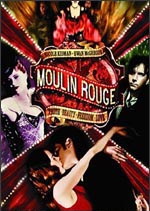
MOULIN ROUGE
Reviewed December 23rd, 2001 by Brian White
I came to this movie not quite knowing what to expect. Much of the media attention surrounding the film was about Nichole Kidman’s marital breakup, and the fact that she and co-star Ewan McGregor were singing in the film. There was also a lot of buzz about the fact that the music in the film was from the seventies and eighties, although the film is set in 1900. What I found was a really mixed bag. It is beautiful, but I wanted it to be more.
Moulin Rouge is a pop-culture assault on the senses. You have, as McGregor put it, a feast for the eyes with the style of the film. This includes wonderful sets, costumes, and CGI to put all of the magic into turn of the last century Paris. The music is a pop-culture smorgasbord. You have so many musical references smashing against each other, that it creates an effect more than the sum of its parts. The movie is a dream-like experience. It is magical.
Apart from the filmed objects, are the excellent camera effects and styles employed by the director. In the beginning, we’re introduced to the world through a flickering black and white film-like effect. You have the crazy pans, close-ups, and the speedups of the camera that you had in Romeo and Juliet, director Baz Luhrmann’s last film. As it turns out, this style is absolutely perfect for music numbers.
Even people who hate musicals may very well love this movie. It’s a lot of fun to guess what song they’re singing. The Roxanne sequence toward the end is stellar.
My difficulty with Moulin Rouge is not unlike my difficulty with Baz Luhrmann. Just when I think he’s brilliant, he does something rather daft. Romeo and Juliet, staring Leonardo DiCaprio and Claire Danes, is a stroke of genius in my books. I love everything about that movie, and I particularly love the style of the film. After Romeo and Juliet, Luhrmann did that God-awful “Sunscreen Song,” that was played way too much on the radio. This was a motivational speech that Luhrmann took it upon himself to popularize to the masses (or was it himself he was trying to popularize?).
Moulin Rouge, like Luhrmann, has so much going for it, but is ultimately not as much as it could have been. I would say that the look of the film and the crazy camera work and editing far surpass that seen in Romeo and Juliet. Luhrmann’s style is very kinetic and fresh. I am happy that people like Luhrmann are making movies like this (I give high plot marks for effort). My question, why does the movie lose steam before the third act? I was in awe for the first hour, but then I got bored. Also, some of Luhrmann’s efforts fall on their faces. The “Like a Virgin” sequence springs to mind. Does Luhrmann take his concept too far, or does he somehow rest on his laurels.
Any criticism of the film is not aimed at the fantastic cast. Kidman and McGregor are excellent, and they can sing to boot (well, they pull it off, anyway)! John Leguizamo, who was also in Romeo and Juliet, is very strong as well. He melts into his character Toulouse-Lautrec, who is different than anyone he’s played. Toulouse is a dwarf, and this illusion is maintained quite well. Jim Broadbent is great as Zidler.
The video on the DVD is fantastic. Presented in anamorphic, 2.35:1 widescreen, the transfer delivers all the color and detail. This is a stunning movie, and the transfer is up to the task of delivering the artistry quite well.
The audio mix is quite dynamic. While very good, the Dolby Digital mix lacks the punch of the DTS track. There is a lot going on throughout the speakers on this DVD. The sound mix is quite complicated at times, with various types of music and conversation at once. The mix handles this quite well.
Moulin Rouge’s two-disc set is a very feature-packed special edition. While watching the film, you can opt to branch to behind the scenes bits about the filmmaking. There are also multi-angle features on Disc 2 for certain dance sequences. There are two feature-length commentaries. The first is the more technical of the two, with Luhrmann, Cathrine Martin and Don McAlpine, who worked on the production. There is also a more anecdotal commentary featuring Luhrmann and his co-writer, Craig Pearce. If Luhrmann can’t convince you of his brilliance on these two commentaries, then perhaps the overly self-congratulatory HBO promotional behind the scenes flick where everyone calls him a genius will. Added to that, you get to see him in his artsy, tied-back hair cut, and his cooler, short-cropped do as well. Disc two contains interviews with the stars and a bunch of other stuff. The menus are really cool.
While this film could and should have been better, it’s still worth a viewing. The DVD represents the film very well.
Please help support our site by buying this DVD title
through this link. Thank you
kindly.
|


 Purchase
This DVD Purchase
This DVD
Story / Content

Audio

Video

Extras

|